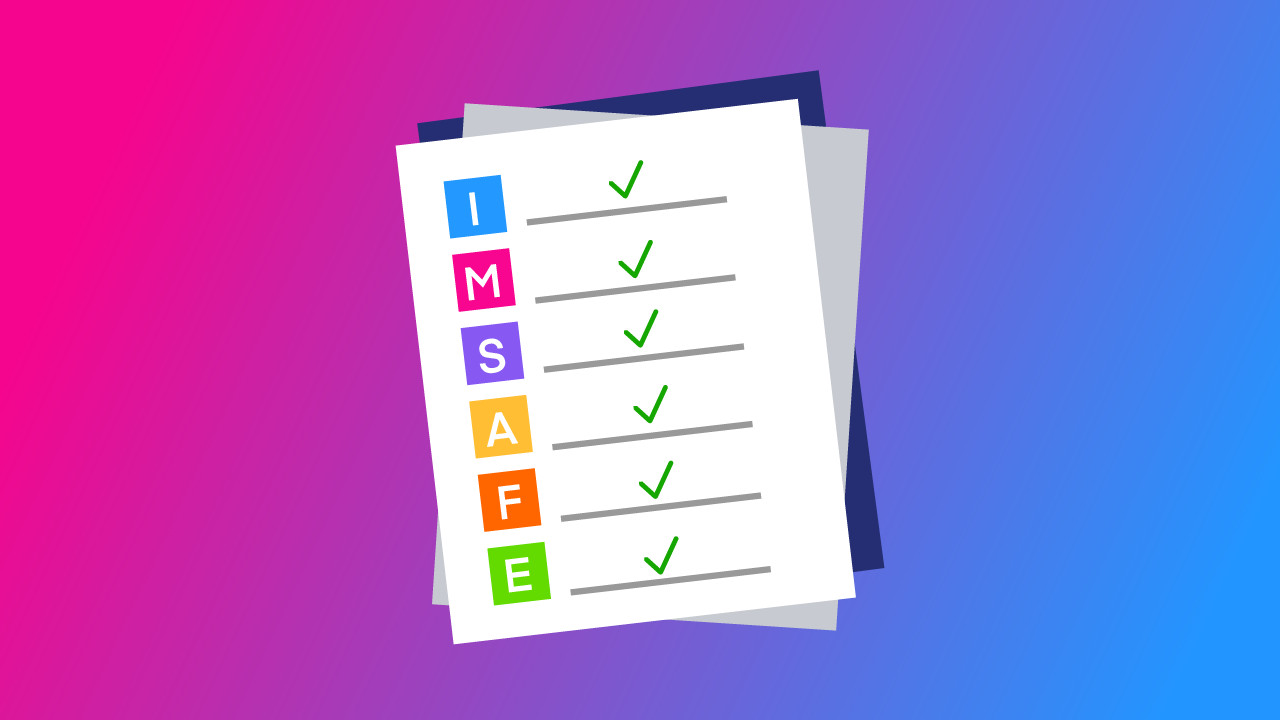Does the thought of calling up Air Traffic Control (ATC) make your palms sweat?
When you press the push-to-talk button, does your mind suddenly go blank?
If so, you’re not alone. Talking with air traffic control is one of the most challenging aspects of flying.
But there’s no need to feel stressed.
In this article, we’ll help you shake off those nerves and start talking to ATC with confidence.
Key Takeaways
- Preparation increases confidence when talking to ATC.
- Anticipating instructions lowers anxiety.
- Do not hesitate to ask for help or let ATC know you are unable to do as instructed.
- There are several resources available to help you improve your ATC skills.
Talking to ATC: 10 Simple Pointers
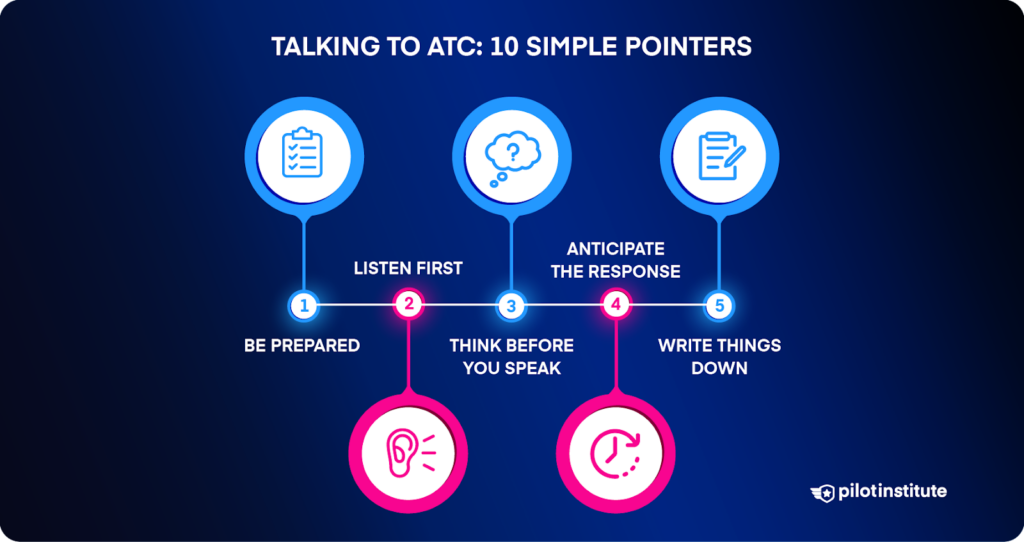
- Be Prepared
Before calling up ATC, take a moment to think about how the conversation will play out. A little bit of mental preparation goes a long way to reducing stress on the radio.
Most ATC interactions involve a request, instructions, and a confirmation. But the specifics change depending on the type of controller you contact.
When calling the ground controller for taxi clearance, have the airport diagram handy. You know you will have to read back the taxi routing and any runway crossing instructions. Make sure you’re familiar with the airport layout.
When it’s time to call up the tower for takeoff clearance, the interaction will be different. Prepare to read back the runway identifier, heading, altitude, and any other instructions you might expect.
Knowing what you need to say, what you will hear, and how to respond will boost your confidence when talking to ATC.
Preparation also means knowing what happens next. Have the radio frequencies for the next controller you will contact readily available.
Having these frequencies at the ready means storing less information in your memory. This reduces the stress and worry of selecting the wrong frequency.
Additionally, if your radio has a standby setting, pre-tune the next ATC frequency. When given the handoff, you can switch to the new controller at the push of a button.
- Listen First
When you switch to a new controller, don’t just key the mic immediately. Let some time pass before transmitting.
What sounds like dead air may actually be a gap in a pilot/ATC exchange. If you transmit immediately, you might step on another person’s transmission. This blocks both you and the other person (pilot or controller) from being heard on the frequency.
Be patient if the new frequency seems very busy with nonstop radio conversation. If you have a complicated request, such as VFR flight following, only transmit your callsign.
ATC will get back to you when their workload permits. This technique prevents overloading the controller with information when they’re task-saturated. After all, they are only human.
- Think Before You Speak
Before activating the microphone to transmit, plan out your message.
A simple framework you can use is the 4 Ws:
- Who you’re talking to.
- Who you are.
- Where you are.
- What your intentions or requests are.
Be concise, and just like public speaking, avoid “umms” and “ahhs.” Be professional and use standard phraseology.
Here’s an example of a good radio transmission:
“Prescott Tower, November 12345, 10 miles to the north, request full stop landing with information Alpha.“
Can you tell what is going on?
The aircraft N12345 is currently 10 miles North of Prescott Regional Airport. They are calling the Prescott control tower. The pilot is requesting that they would like to land, and they have the current Automatic Terminal Information Service (ATIS) information.
This beats someone who didn’t prepare before transmitting something like this:
“Ahh… Prescott Tower, umm… November 12345 is umm…. 10 miles to the… North, would like to request a…. full stop landing with umm… information Alpha.“
- Anticipate the Response.
Anticipating the response reduces the amount of new information you need to process. This improves confidence and, in turn, improves your radio communications.
Are you ready to taxi?
You already have the airport diagram in front of you. You know what you need to say and what the controller’s response will involve. But take preparation one step further. Try to anticipate what instructions ATC could give you.
If you know the active runway (or runways), you can determine which taxiways will get you there. If ATC gives you a similar routing, you’ll be ready to read the instructions back confidently. Additionally, pre-planning a likely taxi routing reduces the risk of a runway incursion.
When approaching an airport to land, listen to the instructions other aircraft receive. If ATC is clearing aircraft to land on 27L, you can anticipate doing the same.
However, be cautious to avoid expectation bias. In this case, expectation bias means you hear what you want to hear, not what the controller actually says. You must pay close attention to the instructions ATC actually gave, not what you expected them to give.
One way to fight expectation bias is by following our next tip.
- Write Things Down
A short pencil is better than a long memory.
Don’t expect to remember everything; even professional pilots take down notes. This is particularly useful for information you need to reference later.
Write down the instructions you receive from ATC (not the instructions you expect). Read back what you wrote to ATC. Unless the controller disagrees with your readback, you know you have bias-free instructions.
Are you at an unfamiliar airport and forget whether you need to turn left or right? If so, you can look at the route you wrote down.
For complicated clearances, there are formats you can use to help. For example, the CRAFT format helps when receiving flight following or an Instrument Flight Rules clearance.
- Clearance limit – The endpoint of the clearance, often the destination airport.
- Route – Initial departure instructions and the route.
- Altitude – The altitude or altitudes ATC requests you fly.
- Frequency – The next frequency, often the departure control frequency.
- Transponder – A unique transponder code for your flight.
ATC provides all that information in that order in one transmission. With the CRAFT template, you can follow along and make quick notes to read back from.
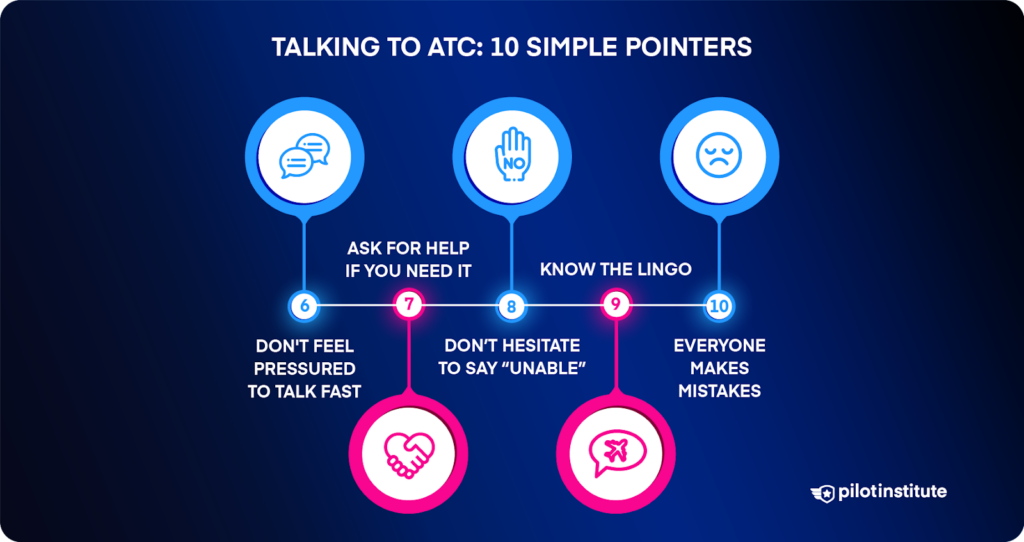
- Don’t Feel Pressured to Talk Fast
As a student pilot, it sounds like everyone on the radio is talking a mile a minute. You may feel you need to talk fast to keep up and “sound professional.”
The thing is, there is no reason why you cannot take your time to communicate. Don’t forget that those fast-talking airliners have two pilots, and the pilot flying is not on the radio. If you’re hand-flying while single-pilot, you have every right to take things slower. Aviate, navigate, and only then, communicate.
If you feel overwhelmed or are a new pilot, let ATC know so they can help you. This includes slowing down their speech for your understanding.
Do not make assumptions if the controller says something you don’t understand completely. Ask them to clarify or repeat the instructions.
- Ask For Help if You Need It
Since controllers are there to help you, don’t hesitate to ask them for assistance.
For example, being at a new airport can be overwhelming, and long taxi instructions can add to the stress.
You can ask the ground controller for a progressive taxi. They will help you navigate the taxiways, instructing you to turn left or right as you reach a junction.
If you’re flying along in deteriorating weather, call up ATC for guidance. They will do everything they can to point you in the right direction. Don’t let your pride get you in over your head. Superior pilots use all the resources they have at their disposal, including ATC.
- Don’t Hesitate to Say “Unable”
The information ATC possesses may differ from yours. After all, they can’t see what you can see from the airplane.
ATC might request an altitude or heading that puts you right into a layer of clouds. Complying with this request would mean violating Visual Flight Rules. It’s not only your right but your duty to say “unable.”
Of course, explaining why you can’t comply helps the controller. If a small change in assigned heading or altitude can keep you clear of clouds, tell them. They can use that information to determine the best course of action.
- Know the Lingo
Have you heard something a controller said that you didn’t understand? How about other pilots? We’d be surprised if you haven’t.
In aviation, communicating clearly and consistently eliminates misunderstandings. Pilots and controllers do this by using common verbal shorthand.
For example, “line up and wait” is only four short words, but it speaks volumes to pilots. They have no doubt as to what the controller expects them to do.
If you’re new to flying, spend some quality time reading the pilot/controller glossary. This document published by the Federal Aviation Administration (FAA) includes all the ATC terms you need to know.
Please do not make up your own non-standard phrases or copy the ones other pilots use. No one wants to hear “any traffic, please advise” when flying at their local airport. And unless you’re a WWII Royal Air Force pilot, “tally ho!” is not an appropriate response to a traffic advisory.
- Everyone Makes Mistakes
All pilots and controllers make mistakes on the radio from time to time. Nobody is perfect.
Don’t let the mistake distract you from your duties as a pilot. After the flight, you can debrief the situation with your instructor or a friend. That’s the time and place to learn from errors.
Of course, the best way to minimize mistakes is to practice.
How to Practice Talking to ATC
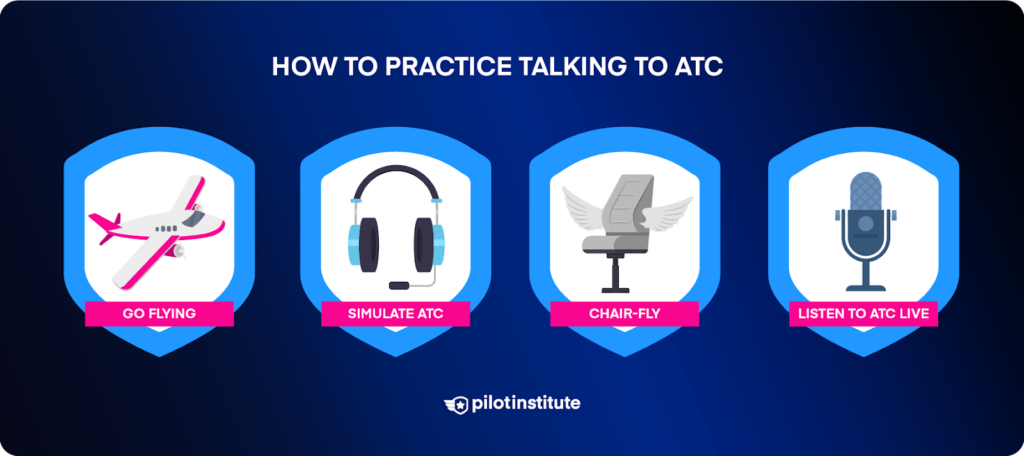
No Substitute for the Real Thing
If you are training at an untowered field, you might not have had much exposure to ATC. During your training, your instructor will eventually bring you to a towered airport. But it takes more than one flight to get the hang of talking on the radio.
Here’s the bottom line: there is no substitute for the real thing. The best way to practice is by talking to ATC while flying. Learning to stay ahead of the aircraft while communicating is part of the challenge.
However, talking with ATC in a hectic aircraft cockpit is a lot for new students to handle. Not to mention, renting airplanes just for ATC practice is expensive.
If you want to improve your ATC skills on the ground, here are some low-stress, cost-effective alternatives.
Simulate ATC
One great way to practice talking with ATC is to use a flight simulator.
However, you can’t use the built-in, text-only ATC functions. That won’t help you. You need to speak with real, live human controllers.
Thankfully, two systems can connect your simulator to virtual controllers: PilotEdge and VATSIM.
These flight simulator communities provide a real-time, fairly realistic ATC environment. You’ll also be flying alongside other virtual aircraft.
Flight simulators are cost-effective training tools. However, they have their drawbacks. They do not provide the same physical feedback as actual flying and can cause some bad habits to form. Make sure you speak with your instructor about using flight simulators in your training.
PlaneEnglish also offers an app called ARSim. This aviation radio simulator allows users to simulate communication between pilots and ATC. Using speech analysis technology, it provides feedback on your aviation phraseology.
Chair-Fly
A tried and true method of practice is chair-flying.
With this technique, you simulate flight scenarios while sitting in a chair on the ground. The focus will be on perfecting your radio procedures. It’s crucial that you speak out loud like you would in the airplane. Simply thinking the radio calls is not very helpful.
Doing this with a CFI or pilot friend is valuable, as they can provide feedback on your radio phraseology.
While this technique is low-stakes, it enables you to practice anywhere you can find a seat.
Listen to ATC Live
LiveATC.net broadcasts ATC frequencies from various airports. You can listen to tower, ground, approach, center, clearance delivery, and more. If LiveATC streams your airport, it’s a great way to listen at home or in the car.
You can also buy a handheld aviation-band receiver to tune in to local ATC frequencies. It is not illegal to listen to ATC on a handheld radio, but you must not transmit on the frequency.
Check out our step-by-step guide if you want to learn more about listening to live ATC.
Try pairing LiveATC with an online flight tracking site like Flightradar24. You can “attach” yourself to aircraft and follow along with their radio communications. Or listen to the arrivals and departures at a specific airport.
ATC Keywords and Phrases
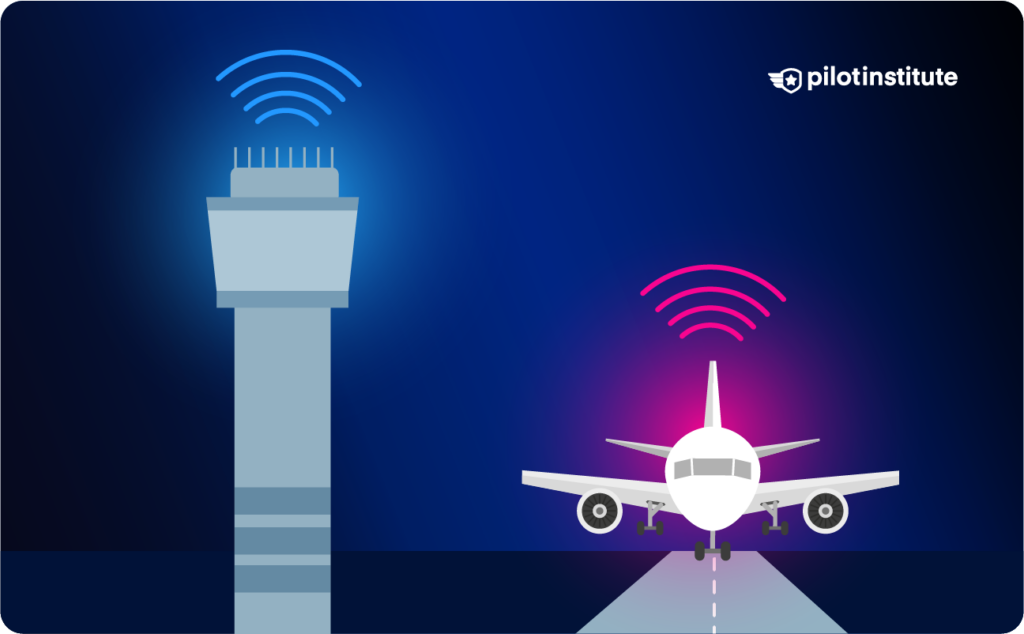
ATC transmissions can be challenging for the brand-new student pilot to understand. Aviation has its own unique way of speaking.
You might notice that pilots and controllers pronounce numbers differently than usual:
- 3 is pronounced “tree.”
- 5 is pronounced “fife.”
- 9 is pronounced “niner.”
This helps pilots and controllers avoid confusing numbers with other words. For this same reason, pilots should avoid using “to” and “for,” which sound like “two” and “four.”
Here are some phrases to help you start your ATC journey:
Line up and wait – Used by ATC to inform a pilot to taxi onto the departure runway and stop. It is not a takeoff clearance.
Final – This means that a landing aircraft has aligned with the runway. You might hear a distance included, like “three-mile final.”
Cleared for the option – Authorization for an aircraft to make a touch-and-go, low approach, missed approach, stop-and-go, or full stop landing.
Ident – A request for a pilot to activate the aircraft transponder identification feature. The ident helps the controller confirm an aircraft’s identity or location.
Squawk – Instructing a pilot to activate the aircraft transponder and ADS-B Out with a specific 4-digit code.
Say again – Used to request a repeat of the last transmission.
Blocked – Previous radio transmission was distorted or interrupted.
Roger – The pilot or controller has received and understood the transmission. It does not mean “affirmative” or “yes.”
Wilco – The pilot has received and understood the instructions and will comply.
Back-taxi – Taxi on the runway opposite to traffic flow. Pilots back-taxi when the taxiway is not available (or doesn’t exist).
Conclusion
While it almost feels like you’re studying a new language, learning how to talk to ATC is a skill all pilots must have.
To improve your radio skills, practice your radio calls every chance you get. Get your instructor’s feedback to ensure you haven’t picked up any bad habits.
Consider visiting your local control tower and meeting the controllers. This lets you to see they are people, too, and you don’t need to be intimidated by them.
After all, they exist to help keep you safe.
Wondering what pilots do at airports without a control tower? Check out the article What is CTAF? Common Traffic Advisory Frequency (CTAF) Explained.



